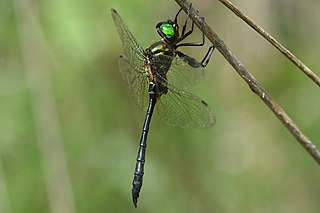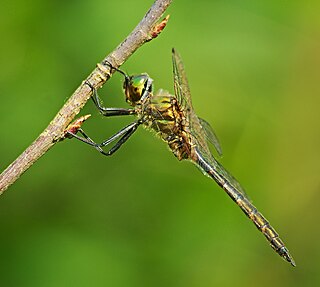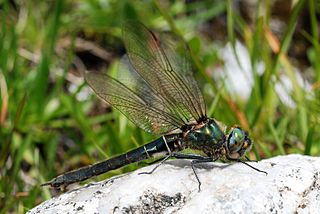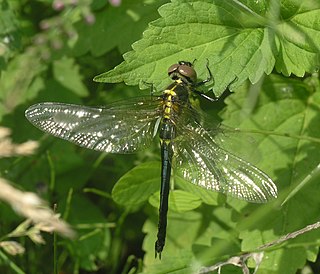
Corduliidae, also knowns as the emeralds, emerald dragonflies, or green-eyed skimmers, is a family of dragonflies. These dragonflies are usually black or dark brown with areas of metallic green or yellow, and most of them have large, emerald-green eyes. The larvae are black, hairy-looking, and usually semiaquatic. This family include species called "baskettails", "emeralds", "sundragons", "shadowdragons", and "boghaunters". They are not uncommon and are found nearly worldwide, but some individual species are quite rare. Hine's emerald dragonfly, for example, is an endangered species in the United States.

Somatochlora, or the striped emeralds, is a genus of dragonflies in the family Corduliidae with 42 described species found across the Northern Hemisphere.

The Bulgarian emerald, Corduliochlora borisi, is a species of dragonfly in the family Corduliidae, and the only species in the genus Corduliochlora. It is found in Bulgaria, Greece, and Turkey. Its natural habitat is rivers. It is threatened by habitat loss. The species is named after Boris Marinov. It was formerly treated as a member of the genus Somatochlora.

The incurvate emerald is a species of dragonfly in the family Corduliidae. It is found in Canada and the United States. Its natural habitat is fens.

Somatochlora sahlbergi, the treeline emerald, is a species of dragonfly in the family Corduliidae. It is found at high latitudes across northern Eurasia and North America, and occurs farther north than any other dragonfly.

The brilliant emerald, Somatochlora metallica, is a middle-sized species of dragonfly. It is the largest and greenest of the Somatochlora species; 50–55 millimetres (2.0–2.2 in) long.

Somatochlora flavomaculata, also called yellow-spotted emerald, is a common species of dragonfly in the family Corduliidae. Its distribution stretches from France to Siberia and Mongolia. It frequents wetlands in its range. The males are known to defend their territory.

Somatochlora provocans, the treetop emerald, is a species of emerald dragonfly in the family Corduliidae. It is found in North America.
Somatochlora hudsonica, the Hudsonian emerald, is a species of emerald dragonfly in the family Corduliidae. It is found in North America.

Somatochlora ensigera, the plains emerald, is a species of dragonfly in the family Corduliidae. It is found in central North America.

Somatochlora alpestris, or the alpine emerald, is a species of dragonfly from the family Corduliidae. It is found in European highlands, southern Scandinavia, and east to southern Siberia in Asia.
Somatochlora shennong is a species of dragonfly in the family Corduliidae. It was described in 2014 based on specimens from Hubei, China, and is also known from Guangxi. It occurs at narrow ditches with dense emergent vegetation. It is related to two other east Asian species: Somatochlora dido and Somatochlora taiwana.
Somatochlora daviesi is a species of dragonfly in the family Corduliidae. It was first described in 1977 based on specimens from Meghalaya, India, and is also known from Nepal and Bhutan. It resembles the east Asian S. dido in its small size and lack of yellow markings on most of the abdomen. Like other species in the genus, S. davisi is predominantly dark metallic brown to green. The formerly recognised Somatochlora nepalensis is now considered to be a synonym of S. daviesi.
Somatochlora dido is a species of dragonfly in the family Corduliidae. It is known from southeastern China and northern Vietnam, but populations in Vietnam may alternatively represent a separate, undescribed, species. S. dido has sometimes been treated as synonymous with S. taiwana from Taiwan, but more recent publications have treated them as separate species. S. shennong is also closely related.

Somatochlora meridionalis, the Balkan emerald, is a species of dragonfly in the family Corduliidae. It occurs in southeastern Europe from France to the Czech Republic to Turkey. It is found at narrow, shallow, shaded streams.
Somatochlora shanxiensis is a species of dragonfly in the family Corduliidae. It is a metallic green to black dragonfly with yellow spots and a total length of 51 to 53 mm. It was described in 1999 based on specimens from Shanxi, China, and has also been recorded in Hubei. It is most similar to Somatochlora graeseri and Somatochlora uchidai.
Somatochlora lingyinensis is a species of dragonfly in the family Corduliidae. It was described in 1979 based on a specimen from Lingyin in Zhejiang, China. No other specimens are known.

Somatochlora exuberata is a species of dragonfly in the family Corduliidae. It is found in eastern Russia, northern China, Korea, and Hokkaido, Japan.

Somatochlora graeseri is a species of dragonfly in the family Corduliidae. It is found in Asia, where it occurs in Japan, Korea, northern China, and Russia.













